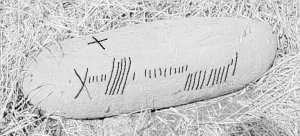Thesaurus Indogermanischer Text- und Sprachmaterialien
Ogam-Inschrift: CIIC-Nr. 156
Ogam Inscription: CIIC no. 156
Original location: Ballintaggart
County: Kerry
Surroundings: Burial Ground
Year of discovery: 0
Actual location: =
Illustrations:



Actual reading:
Latin Transcription: MAQQI IARI (K)[OI] MAQQI MUCCOI DOVVINIAS
Ogam Transcription: пвононедедвтсед(х)[гед]пвононедпдомомгедмгййедкйедвки Ogam Transliteration: пвлллллжлллллвввввжвввввжвпппппввввв(хв)[вжввввв]пвлллллжлллллвввввпвввллллжллллввжвввввллввзззжзззвввввзззззвввввжвзззз
Direction of reading: "du-tr-sd"
Other readings, history, comments etc.:
Location and history:
For the location and discovery, cf. {155.}.
Size according to Brash, OIM 201 ("No. 2"): 3'4" x 13" x 10"
Size according to Macalister, CIIC: 3'6" x 1'1" x 0'5"
Published illustrations:
- Brash, OIM pl. XXIII, no. 2. (draft);
- Macalister, CIIC 1, 152 (draft).
"N(orth) Side":
MAQQI [M?] ARIAI
"S(outh) Side":
MAQQIMUCOIDOFFINIAS
"Proposed verbation":
maqqi [m]ariai. maqqi muccoi doffinias.
The stone is assigned "No. XIX" in Ferguson's "List of Moulds of Inscribed Stones from .. Localities in the Barony of Corkaguiney".
Reading Brash, OIM 201 ("No. 2"):
пвононедедвтседхедпвононедпгомомгегмгййедкйедвки
MAQQIIARI IMAQQOMOCCOEDOFFINIAS
Brash's copy "agrees with Mr. Windele's". The reading is beyond doubt. - Cp. the name Magari on an "inscription in debased Roman letters" in Cornwall, at Worthyvale, near Camelford" {470}.
MAQQIIARIPOIMAQQIMUCCOiDoFFINIAS
EA
"Maqqi Iari poi maqqi muccoi Doffinias."
"This is one of the most clearly inscribed and easily transliterated of the group." - A "name Iar, father of the father of four virgins" is "stated to be venerated at Cell Ingen Iarяin and in Corkaguiney" according to the F‚lire ’ng., 26. Oct.; cf. TRIA, Ir.Ser. 1, clix. Maqi Iari may "be suppoesd to have been a person of sufficient distinction to have been remembered as son - perhaps only son - of his father. Or it may be that such formulas were in use when the son was called after the father, or by a diminution of the father's name, as in `Cell Ingen Iarяin'."
MAQQI-IARIPI
This can be compared with Mac Erp.
пвононедедвтседхедпвононедпдомомгедмгййедкйедвки
MAQQIIARIKIMAQQIMUCCOIDOVVINIAS
U2,3 "run together", and I1 of MUCCOI "struggles out of the direct line". - Besides RhЯs's proposal of comparing Maqqi-Iaripi with Mac Erp, one could think of reading Maqqi-Iariki, to be connected with Mac Erc, "though orthography and accidence are both against it." But on "three other unquestionable monuments of the Corco Duibne, the "mythic ancestress' name" [i.e., DOVVINIA] is associated with "Erc, or its feminine Ercis"; cf. Coumeenoole {178}! "Another possibility would be to read Maqqi-Iari ki, taking ki in the sense which seemed distantly possible for cci on Ballinrannig VI {153}. - "Dovv-in- is a derivative in -in- from a base *Dov-, also traceable in Dov-et- {157}, Dov-aidon- {503: Ballaqueeny / Man}. - [Additional remark in Epig. 3, 6:] "Maqqi-Iariki must be resolved into Maqqi-Iari ki, the ki being the same as cci at Ballinrannig {153} and the koi which appears on a certain number of stones."
Inscription up-top-down:
MAQQI-IARI KOI MAQQI MUCCOI DOVVINIAS
"The vowels of KOI are so cramped and faint that it is difficult to avoid mistaking the word for -KI, appended to the name IARI. But KOI is certainly correct".
Macalister's reading cannot be falsified.
MAQQI IARI KOI MAQQI MUCCOI DOVVINIAS
The inscription is well preserved. The only late trait in the otherwise archaic inscription is the usage of the forfed K.
MAQQI IARI kOI MAQQI MuCCOI DOVVINIAS
Reading Gippert (1978):
"Surface angle,  dexter - top - right":
dexter - top - right":
MAQQI IARI (K)[OI] MAQQI MUCCOI DOVVINIAS
пвононедедвтсед(х)[гед]пвононедпдомомгедмгййедкйедвки
пвлллллжлллллвввввжвввввжвпппппввввв(хв)[вжввввв]пвлллллжлллллвввввпвввллллжллллввжвввввллввзззжзззвввввзззззвввввжвзззз
While the х forfed is still quite clear, the vowel notches that were read on the "top" of the stone by others are hardly recognizable at all.
Additional literature:
- F‚lire ’ngusa in TRIA, Ir.Ser., Vol. 1, CLIX.
'.Last changes of this record: 27.04.97
Copyright Jost Gippert, Frankfurt a/M 1996. No parts of this document may be republished in any form without prior permission by the copyright holder.  dexter - top - right":
dexter - top - right":
